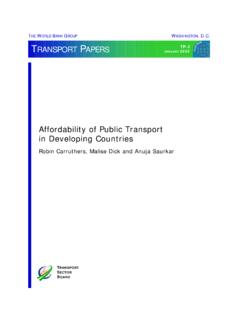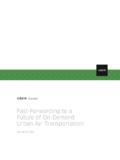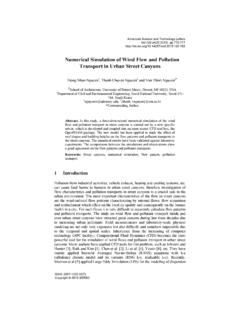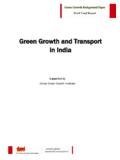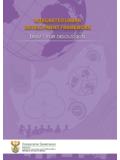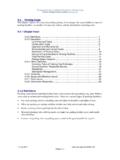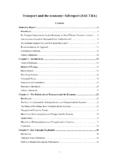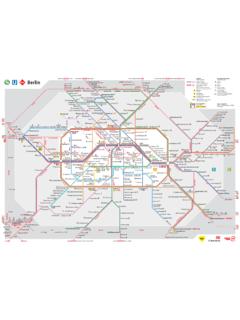Transcription of Conducting Impact Evaluations in - World Bank
1 Conducting Impact Evaluations in urban transport January 2007. Acknowledgement This paper was written by Marlon G. Boarnet. 1 The work was task managed by Judy Baker and Markus Goldstein. The paper benefited greatly from comments by participants in a World Bank workshop and staff of the transport anchor at the World Bank. This work program was financed by the Trust Fund for Environmentally &. Socially Sustainable Development and by the Bank-Netherlands Partnership Programs fund. 1. Department of Planning, Policy, and Design, Department of Economics, University of California, Irvine. The opinions reflected in this paper are the opinions of the author and not opinions of their institution. TABLE OF CONTENTS. INTRODUCTION .. 1. I. COST-BENEFIT ANALYSIS AND Impact evaluation FOR urban transport PROJECTS .. 2. II. World BANK urban transport PROJECTS .. 5. III.
2 Impact evaluation AND METHODOLOGICAL ISSUES RELATED TO urban 7. IV. EVALUATING LABOR MARKET IMPACTS OF urban transport PROJECTS .. 11. A. 11. B. EXAMPLES THAT SUGGEST A LINK BETWEEN TRANSPORTATION ACCESS. AND LABOR MARKET SUCCESS .. 12. C. VARIABLES .. 13. D. DATA 15. E. METHODOLOGICAL APPROACHES AND CHALLENGES .. 16. F. EXAMPLES OF LABOR MARKET Impact 20. G. SPECIAL METHODOLOGICAL CONSIDERATIONS FOR LABOR MARKET Impact evaluation . IN DEVELOPING 22. V. EVALUATING THE Impact OF transport PROJECTS ON ECONOMIC OPPORTUNITIES .. 24. A. TRANSPORTATION AND ECONOMIC OPPORTUNITIES .. 24. B. VARIABLES .. 25. C. DATA 27. D. METHODOLOGICAL APPROACHES AND CHALLENGES .. 27. E. EXAMPLES OF Evaluations OF FIRM LOCATION AND transport 28. VI. EVALUATING THE Impact OF urban transport PROJECTS ON ACCESS. TO AND USE OF 31. A. 31. B. VARIABLES .. 32. C. DATA 33. D. METHODOLOGICAL APPROACHES AND CHALLENGES.
3 33. E. EXAMPLES OF STUDIES OF TRANSPORTATION AND ACCESS TO SERVICES .. 34. VII. EVALUATING THE Impact OF urban transport PROJECTS ON LAND PRICES .. 36. A. 36. B. VARIABLES .. 36. C. DATA 38. D. METHODOLOGICAL APPROACHES AND CHALLENGES .. 39. E. EXAMPLES OF STUDIES OF TRANSPORTATION ACCESS AND HOUSE PRICES .. 39. F. CAUTION: HOUSE PRICE ANALYSIS IN WEAK OR INCOMPLETE LAND MARKETS .. 42. VIII. Impact evaluation FOR REGULATORY REFORM 44. CONCLUSIONS .. 45. BIBLIOGRAPHY .. 48. Introduction This paper summarizes methodological approaches for evaluating the role of urban transportation projects in poverty alleviation. Poverty Impact Evaluations are becoming more common within the World Bank. See, for example, the handbook developed by Baker (2000). Yet Impact Evaluations of urban transportation projects are still rare, especially in developing countries. Impact evaluation can illuminate causal sequences and links to poverty alleviation in ways that go beyond the insights from a standard cost-benefit analysis.
4 Impact evaluation applied to urban transport has much promise, but the literature provides few examples of transport Impact evaluation in the developing World . The purpose of this paper is to summarize the literature, often from developed countries, and to interpret that literature in ways that provides methodological guidance for pursuing poverty Impact Evaluations of urban transport in developing countries. Impact Evaluations of urban transportation projects present special challenges, including interactions with other markets and potential selection biases. To start, consider the endogeneity problem associated with urban transportation projects. urban economic theory holds that city dwellers will adjust their location choices and travel patterns in response to urban transportation projects. Some of these readjustments may be at least in part the intended goal of the project.
5 Firms, businesses, and non-profit or government organizations may also change their locations in response to changes in accessibility. As an example, imagine the construction of a transit line that improves access to employment centers. After the new line opens, motivated job seekers might move near the line to be closer to employment opportunities. After construction of this hypothetical transit line, when one observes that persons living near the line have higher employment rates, a researcher would need to adjust for the possibility that persons moved near the line in part based on their attachment to the labor market. Employable persons might have chosen to move near the new transit stations, as distinct from any effect the new transit line might have had on the employment prospects of persons who lived near the line before the project was built. More generally, urban transportation influences the land market and the market for travel in ways that are endogenous to the transportation intervention, and Evaluations must deal with that endogeneity.
6 Complicating matters further, poverty impacts are usually an indirect result of an urban transportation project, not a direct result. Transportation projects are pursued for mobility goals, such as reduced travel times. These reductions in travel times may have impacts on poverty. For example, commuters may take more distant jobs if commute times are reduced, which could reduce poverty for residents who live far from job centers. Yet the data typically used to evaluate the mobility goals of an urban transportation project will not be sufficient to assess the poverty Impact . The transportation outcome variable a change in mobility, access, or travel time will often be an independent variable in a study of a poverty related outcome. Hence in addition to the endogeneity and selection problems mentioned above, poverty Evaluations for urban 1. transportation projects can bring data collection requirements that go beyond the usual data collected in that sector.
7 Lastly, poverty Impact Evaluations in the urban transport sector present theoretical challenges. A longstanding tenet of transportation economics is that the benefits of transportation projects can be completely measured by the benefits that appear in the market for transportation. Hence reduced travel time, reductions in vehicle operating costs, and reductions in transportation-related accidents are considered to be complete measures of project benefits in the absence of externalities or market imperfections. Transportation economists have long cautioned against adding benefits in other markets to mobility benefits, as that would double count the benefits of a transportation project. For discussions, see Boarnet (1997, p. 477) Mohring (1961), Mohring and Harwitz (1962) and Wheaton (1977). Poverty Impact Evaluations typically examine other markets;. for example, a poverty Impact evaluation might examine how labor market outcomes are related to an urban transportation project.
8 While such an evaluation will illuminate how the transportation project relates to the World Bank's core mission of poverty alleviation, partial equilibrium analysis of poverty impacts is not the same as a welfare measure, and the difference between the two can be large. Double counting project benefits by, for example, adding Impact measures to benefits measured in the transport market will inappropriately inflate the benefits of the project. These challenges can often be overcome. Rigorous assessment of the poverty Impact of urban transportation projects is possible. This paper provides a guide to implementing Evaluations of the poverty alleviation Impact of urban transportation. That guide begins, in Section I, with some background on the relationship between traditional transportation cost-benefit analysis and poverty Impact Evaluations . Section II. provides background on recent World Bank urban poverty projects.
9 Section III briefly discusses classical Impact evaluation approaches, and particular methodological challenges inherent in applying those approaches to urban transportation projects. Section IV discusses types of impacts that would be typical foci for evaluation studies related to urban transport . Section V discusses methods for assessing the Impact of urban transport projects on labor market outcomes of the poor. Section VI examines Impact evaluation related to firm location. Section VII discusses evaluation methods to evaluate the Impact of transport projects on access to services. Section VIII discusses methods to evaluate impacts on land prices, and the final section concludes. I. Cost-Benefit Analysis and Impact evaluation for urban transport Projects Methods for cost-benefit analysis of transportation projects are well established. Costs are typically determined by actual (discounted) project costs, or the opportunity costs of resources devoted to the project, in a manner consistent with general cost-benefit analysis principles.
10 See, , Gramlich (1997) for a discussion. Benefits are typically 2. divided into three parts reductions in travel times, reductions in vehicle operating costs, and reductions in accidents ( AASHTO, 1977; Forkenbrock and Foster, 1990). All benefits are monetized; for a discussion, see, , Small (1992). Wheaton (1977) shows that, absent externalities or imperfect competition, the benefits of urban transportation investments can be obtained from an appropriate surplus measure derived from a well-specified travel demand function. This is consistent with focusing only on the mobility or transportation benefits of urban transportation projects, as per the common practice described above. Other benefits, such as land price changes or reductions in shipping costs, are not distinct benefits but simply reflections of transport benefits in other markets. As such, it is not appropriate to count both transport market benefits and benefits in other markets that flow strictly from changes in the transport market; counting both would be double counting the benefits of the transportation investment.










